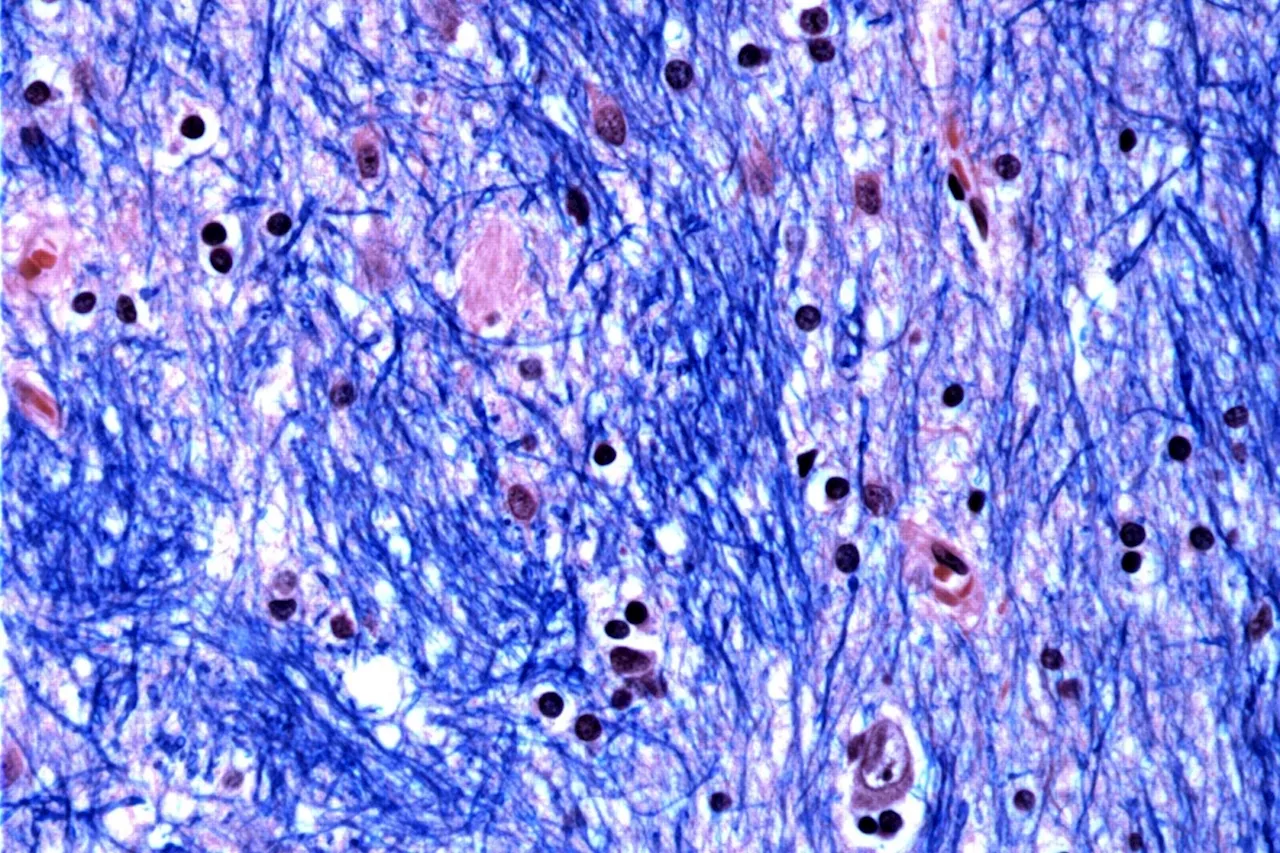A groundbreaking study reveals that the genetic mutation responsible for Huntington's disease remains harmless for decades before gradually expanding and triggering the production of toxic proteins. This finding offers hope for developing new treatment strategies to delay or prevent the onset of this debilitating and fatal disorder.
Scientists have made a groundbreaking discovery regarding the onset of Huntington's disease, a debilitating and fatal inherited disorder that manifests in the prime of life. This condition causes the deterioration and death of nerve cells in specific brain regions. While the genetic mutation linked to Huntington's has been known for years, the reason why individuals carrying the mutation don't experience symptoms until later in life remained a mystery.
New research reveals that the mutation, surprisingly, remains harmless for decades. However, it gradually grows into a larger mutation over time until it eventually surpasses a critical threshold. This expansion triggers the production of toxic proteins, ultimately leading to the death of the cells it has affected. Dr. Mark Mehler, who directs the Institute for Brain Disorders and Neural Regeneration at the Albert Einstein College of Medicine and was not involved in the research, hailed this study as a 'landmark' achievement, stating that it addresses many longstanding issues within the field.The progressive brain cell death results in impairments in movement, thinking, and behavior. Symptoms of Huntington's, including involuntary movements, unsteady gait, personality changes, and diminished judgment, typically emerge between the ages of 30 and 50, gradually worsening over a period of 10 to 25 years.Scientists at the Broad Institute of MIT and Harvard, McLean Hospital in Massachusetts, and Harvard Medical School conducted a comprehensive analysis of brain tissue donated by 53 individuals with Huntington's and 50 without the condition. They examined half a million cells, focusing on the Huntington's mutation, which involves an extended stretch of DNA within a specific gene. This stretch contains a three-letter sequence – CAG – repeated at least 40 times. In individuals without the disease, this sequence is repeated only 15 to 35 times. The researchers discovered that DNA tracts with 40 or more such 'repeats' expand over time, reaching hundreds of CAGs in length. Once the CAGs exceed a threshold of approximately 150, specific types of neurons become diseased and die. This finding was unexpected, even to the research team, according to Steve McCarroll, a Broad member and co-senior author of the study, published in the journal Cell. The study was partially funded by the Howard Hughes Medical Institute.The research team estimated that repeat tracts grow slowly during the first two decades of life, then the rate accelerates significantly when they reach around 80 CAGs. Sabina Berretta, a neuroscience researcher and one of the study's senior authors, explained that 'The longer the repeats, the earlier in life the onset will happen.'Researchers acknowledged that initial skepticism arose from previous studies suggesting that repeat expansions between 30 and 100 CAGs were necessary but insufficient to cause Huntington's. McCarroll agreed that 100 or fewer CAGs are not sufficient to trigger the disease, but asserted that expansions with at least 150 CAGs are.These findings offer hope that scientists can develop strategies to delay or prevent this incurable condition, which affects approximately 41,000 Americans. Currently, treatment focuses on managing the symptoms with medications. Recent experimental drugs aimed at reducing the levels of the protein produced by the mutated Huntington's gene have faced challenges in trials. The new research suggests that this may be because only a small number of cells possess the toxic form of the protein at any given time.Researchers propose that slowing or halting the expansion of DNA repeats could be a more effective approach to targeting the disease. Although there are no guarantees that this would prevent Huntington's, McCarroll stated that 'many companies are starting or expanding programs to try to do this.
Huntington's Disease Genetic Mutation DNA Expansion Toxic Proteins Treatment Research
Philippines Latest News, Philippines Headlines
Similar News:You can also read news stories similar to this one that we have collected from other news sources.
 Philippines Temporarily Bans Indian Buffalo Meat Imports Due to Foot-and-Mouth Disease OutbreakThe Philippine Department of Agriculture (DA) has temporarily banned the entry of Indian buffalo meat (IBM) from three states—Bihar, Maharashtra, and Telangana—following an outbreak of the highly contagious foot-and-mouth disease (FMD). The ban, issued through Memorandum Order (MO) 59, aims to protect the local livestock population from the spread of FMD. All existing shipments in transit will be accepted if they test negative for the FMD virus, while previously approved import clearances for shipments originating from the affected states have been revoked.
Philippines Temporarily Bans Indian Buffalo Meat Imports Due to Foot-and-Mouth Disease OutbreakThe Philippine Department of Agriculture (DA) has temporarily banned the entry of Indian buffalo meat (IBM) from three states—Bihar, Maharashtra, and Telangana—following an outbreak of the highly contagious foot-and-mouth disease (FMD). The ban, issued through Memorandum Order (MO) 59, aims to protect the local livestock population from the spread of FMD. All existing shipments in transit will be accepted if they test negative for the FMD virus, while previously approved import clearances for shipments originating from the affected states have been revoked.
Read more »
 Ivory Coast Cocoa Harvest Threatened by Bad Weather and DiseaseThe outlook for Ivory Coast's cocoa harvest is souring due to bad weather and a virulent crop disease. This could deepen a global supply crunch and further drive up prices. Production in the country, which accounts for over a third of global production, is expected to fall nearly 10 percent from initial estimates.
Ivory Coast Cocoa Harvest Threatened by Bad Weather and DiseaseThe outlook for Ivory Coast's cocoa harvest is souring due to bad weather and a virulent crop disease. This could deepen a global supply crunch and further drive up prices. Production in the country, which accounts for over a third of global production, is expected to fall nearly 10 percent from initial estimates.
Read more »
 Philippines Ready to Face Emerging Diseases Amid 'Disease X' Outbreak in CongoThe Philippines is prepared to handle any potential health threats, including an unidentified illness called 'Disease X' affecting the Democratic Republic of Congo. The World Health Organization (WHO) has reported 406 cases with 31 fatalities, mostly children under five. Symptoms resemble common illnesses like fever, cough, and headache. While transmission within households is suspected, further data is needed for confirmation. Health Secretary Teodoro Herbosa emphasizes the Philippines' ability to manage health crises, drawing on lessons learned from the Covid-19 pandemic.
Philippines Ready to Face Emerging Diseases Amid 'Disease X' Outbreak in CongoThe Philippines is prepared to handle any potential health threats, including an unidentified illness called 'Disease X' affecting the Democratic Republic of Congo. The World Health Organization (WHO) has reported 406 cases with 31 fatalities, mostly children under five. Symptoms resemble common illnesses like fever, cough, and headache. While transmission within households is suspected, further data is needed for confirmation. Health Secretary Teodoro Herbosa emphasizes the Philippines' ability to manage health crises, drawing on lessons learned from the Covid-19 pandemic.
Read more »
 Asian Hospital Launches Interstitial Lung Disease CenterAsian Hospital and Medical Center, with Boehringer Ingelheim's support, has opened the Interstitial Lung Disease Center within the Asian Institute of Respirology. This specialized facility aims to provide comprehensive care for ILD patients, integrating advanced diagnostics, personalized treatments, and ongoing support.
Asian Hospital Launches Interstitial Lung Disease CenterAsian Hospital and Medical Center, with Boehringer Ingelheim's support, has opened the Interstitial Lung Disease Center within the Asian Institute of Respirology. This specialized facility aims to provide comprehensive care for ILD patients, integrating advanced diagnostics, personalized treatments, and ongoing support.
Read more »
 PhilHealth Expands Coverage for Heart Disease TreatmentPhilHealth increases benefits for heart attack treatment, covering essential services and procedures.
PhilHealth Expands Coverage for Heart Disease TreatmentPhilHealth increases benefits for heart attack treatment, covering essential services and procedures.
Read more »
 PhilHealth Expands Coverage for Heart Disease Treatment in the PhilippinesTo address the leading cause of death in the Philippines, PhilHealth increases its benefits coverage for heart attacks and related treatments.
PhilHealth Expands Coverage for Heart Disease Treatment in the PhilippinesTo address the leading cause of death in the Philippines, PhilHealth increases its benefits coverage for heart attacks and related treatments.
Read more »
